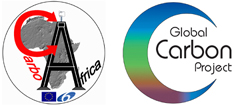Drivers of inter-annual variability in Net Ecosystem Exchange in a semi-arid savanna ecosystem, South Africa
Abstract. Inter-annual variability in primary production and ecosystem respiration was explored using eddy-covariance data at a semi-arid savanna site in the Kruger Park, South Africa. New methods of extrapolating night-time respiration to the entire day and filling gaps in eddy-covariance data in semi-arid systems were developed. Net ecosystem exchange (NEE) in these systems occurs as pulses associated with rainfall events, a pattern not well-represented in current standard gap-filling procedures developed primarily for temperate flux sites. They furthermore do not take into account the decrease in respiration at high soil temperatures. An artificial neural network (ANN) model incorporating these features predicted measured fluxes accurately (MAE 0.42 gC/m2/day), and was able to represent the seasonal patterns of photosynthesis and respiration at the site. The amount of green leaf area (indexed using satellite-derived estimates of fractional interception of photosynthetically active radiation fAPAR), and the timing and magnitude of rainfall events, were the two most important predictors used in the ANN model. These drivers were also identified by multiple linear regressions (MLR), with strong interactive effects. The annual integral of the filled NEE data was found to range from −138 to +155 g C/m2/y over the 5 year eddy covariance measurement period. When applied to a 25 year time series of meteorological data, the ANN model predicts an annual mean NEE of 75(±105) g C/m2/y. The main correlates of this inter-annual variability were found to be variation in the amount of absorbed photosynthetically active radiation (APAR), length of the growing season, and number of days in the year when moisture was available in the soil.






